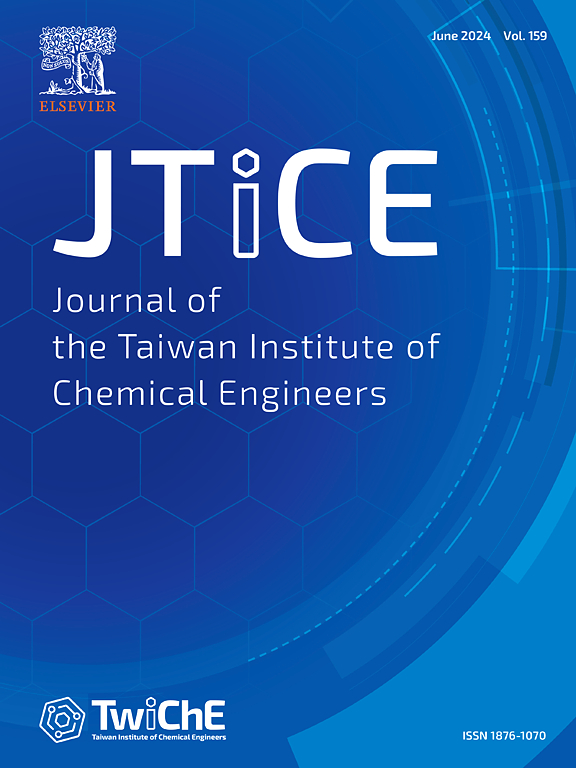稀土金属掺杂CeO2纳米花催化CO2和甲醇合成碳酸二甲酯
IF 5.5
3区 工程技术
Q1 ENGINEERING, CHEMICAL
Journal of the Taiwan Institute of Chemical Engineers
Pub Date : 2025-07-15
DOI:10.1016/j.jtice.2025.106293
引用次数: 0
摘要
二氧化碳与甲醇直接合成碳酸二甲酯(DMC)作为控制和利用二氧化碳的一种有效方法受到了广泛关注,而高效的催化是该工艺的关键。方法采用水热辅助共沉淀法制备掺杂稀土金属(M=La、Pr或Nd)的sceo2基纳米花(M- ceo2 - nf)。研究了稀土金属掺杂对催化剂性能和催化性能的影响。进一步揭示了掺杂金属与CeO2的相互作用及其催化机理。重要发现稀土金属掺杂(1%摩尔含量)可以在不改变催化剂纳米花结构的情况下调节催化剂的比表面积、孔结构和表面氧空位性质,从而影响催化剂的催化性能。NdCeO2 NF的氧空位含量最高,DMC产率为9.58 mmol·g-1 cat。,与纯CeO2-NF相比提高了32%。此外,NdCeO2-NF催化剂也显示出相当大的可重复使用性。根据现场红外表征和催化反应的实验结果,提出了一种可能的反应途径。本文章由计算机程序翻译,如有差异,请以英文原文为准。

Catalytic Synthesis of Dimethyl Carbonate from CO2 and Methanol with Rare Earth metals doped CeO2 nano-flowers
Background
As an effective approach to the control and utilization of CO2, the direct synthesis of dimethyl carbonate (DMC) from CO2 and methanol has received widespread attention, while efficient catalysis is extremely crucial for this process.
Methods
CeO2 based nano-flowers (M-CeO2-NF) doped with rare earth metals (M=La, Pr, or Nd) was prepared by hydrothermally assisted coprecipitation method. The roles of rare earth metal doping on properties and catalytic performance were investigated. The interactions between the doped metals and CeO2 and the mechanism of the catalytic process are further revealed.
Significant Findings
Rare earth metal doping (1 % molar content) can adjust the specific surface area, pore structure, and surface oxygen vacancy properties without changing the nanoflower structure of the catalysts, thereby influencing their catalytic performance. The Nd![]() CeO2 NF exhibited the highest content of oxygen vacancy and presented the superior DMC productivity of 9.58 mmol·g-1 cat., improved by 32 % compared with pure CeO2-NF. Additionally, the Nd
CeO2 NF exhibited the highest content of oxygen vacancy and presented the superior DMC productivity of 9.58 mmol·g-1 cat., improved by 32 % compared with pure CeO2-NF. Additionally, the Nd![]() CeO2-NF catalyst also show considerable reusability. A possible reaction pathway was proposed based on the in-situ infrared characterization and the experimental results of the catalytic reaction.
CeO2-NF catalyst also show considerable reusability. A possible reaction pathway was proposed based on the in-situ infrared characterization and the experimental results of the catalytic reaction.
求助全文
通过发布文献求助,成功后即可免费获取论文全文。
去求助
来源期刊
CiteScore
9.10
自引率
14.00%
发文量
362
审稿时长
35 days
期刊介绍:
Journal of the Taiwan Institute of Chemical Engineers (formerly known as Journal of the Chinese Institute of Chemical Engineers) publishes original works, from fundamental principles to practical applications, in the broad field of chemical engineering with special focus on three aspects: Chemical and Biomolecular Science and Technology, Energy and Environmental Science and Technology, and Materials Science and Technology. Authors should choose for their manuscript an appropriate aspect section and a few related classifications when submitting to the journal online.

 求助内容:
求助内容: 应助结果提醒方式:
应助结果提醒方式:


